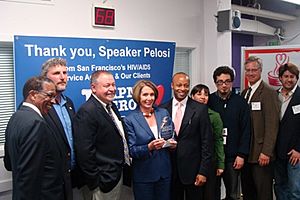Project Open Hand facts for kids
Project Open Hand is a special group in California that helps people. It's a nonprofit organization, which means it doesn't make money for itself. Instead, it gives healthy meals and groceries to older people and those who can't leave their homes. They help people in San Francisco and Alameda County.
Project Open Hand started in 1985. At first, it focused on delivering meals to people with a serious illness called AIDS. Over time, it also started running food banks. In recent years, it has grown to help people with many other long-term health problems. They also serve lunches to seniors. Their main office is at 730 Polk Street in San Francisco. Paul Hepfer is the CEO, or leader, of the organization.
Contents
How Project Open Hand Started
Project Open Hand was created in 1985 by a woman named Ruth Brinker. She had worked with food and helped lead another group called Meals on Wheels. Ruth saw that there weren't many services for people with HIV, which can lead to AIDS. These individuals especially needed good, healthy food because there was no cure for AIDS at that time.
Early Days and Growth
The project began by delivering meals to just seven people with AIDS. It got its first money, $2,000, from the San Francisco Zen Center and the Golden Gate Business Association. Ruth first cooked meals in her own kitchen. Later, they moved to Trinity Episcopal Church.
In 1987, a grant from the Chevron Corporation helped them get a professional kitchen. Project Open Hand also started running a food bank. In 1991, they took over another food bank that helped people with AIDS. By 1988, they were serving 500 meals every day!
Expanding to Oakland
Project Open Hand opened a branch in Oakland on October 17, 1989. This was the same day as the Loma Prieta earthquake. In 1996, they opened a second professional kitchen in Oakland. A year later, in 1997, they moved their main office to 730 Polk Street in San Francisco. They bought this building to be their headquarters.
Helping More People
Tom Nolan was the executive director from 1994 to 2011. He started to expand the group's mission. This meant they began helping not just people with AIDS, but also senior citizens and people with other serious or long-term illnesses like diabetes.
Kevin Winge took over after Tom Nolan. He expanded the food pickup services even more. Now, people with conditions like breast cancer and heart disease could also get food. Mark Ryle became the director in 2016, and Paul Hepfer took over in March 2019.
Food is Medicine Program
From 2014 to 2016, Project Open Hand worked with the University of California, San Francisco. They studied how healthy food helps sick people. Since June 2017, Project Open Hand has been a big part of "Food is Medicine." This is a state-funded project that gives special meals to people with long-term illnesses who get help through Medi-Cal. Medi-Cal is California's health program for people who need assistance.
How Project Open Hand Works
Many people help Project Open Hand through volunteering. In 2003, about 125 volunteers helped every day. The organization gets money from donations, including from groups like the Isabel Allende Foundation. They also receive help from the government and the city.
Services Provided
In June 1996, Project Open Hand delivered 1,600 dinners daily. They also gave out 1,500 bags of groceries each week. Their food bank provided up to 300 bags of groceries to people who walked in. By July 2003, they were serving almost 2,000 clients every day. In 2004, they had helped a total of 30,000 people.
By August 2011, they were getting $5.6 million each year in donations and government money. They were serving almost 2,600 meals a day. These meals went to seniors and people with cancer and other serious illnesses, not just AIDS. They also continued to provide groceries.
In April 2015, Project Open Hand had a budget of $10 million. They served about 8,000 clients. This included 4,400 people in their senior lunch program. As of February 2019, they provided 2,500 meals and 200 bags of groceries daily. Before 2020, when the COVID-19 pandemic started, they also hosted holiday parties at the end of the year.
Financial Care
When Project Open Hand started, many groups focused on helping people quickly. Sometimes, they didn't keep perfect records. After some questions were raised, Project Open Hand made sure to have a board of directors. They also checked their finances carefully. In the late 1980s and early 1990s, their money was looked into, and everything was found to be handled correctly.
A Special Gift
The singer-songwriter Sylvester made a special request in his will. He wanted the money from his music after he passed away to go to Project Open Hand and another group called the AIDS Emergency Fund. After his old debts were paid in the 1990s, the money from his music has been split between these two organizations ever since.


